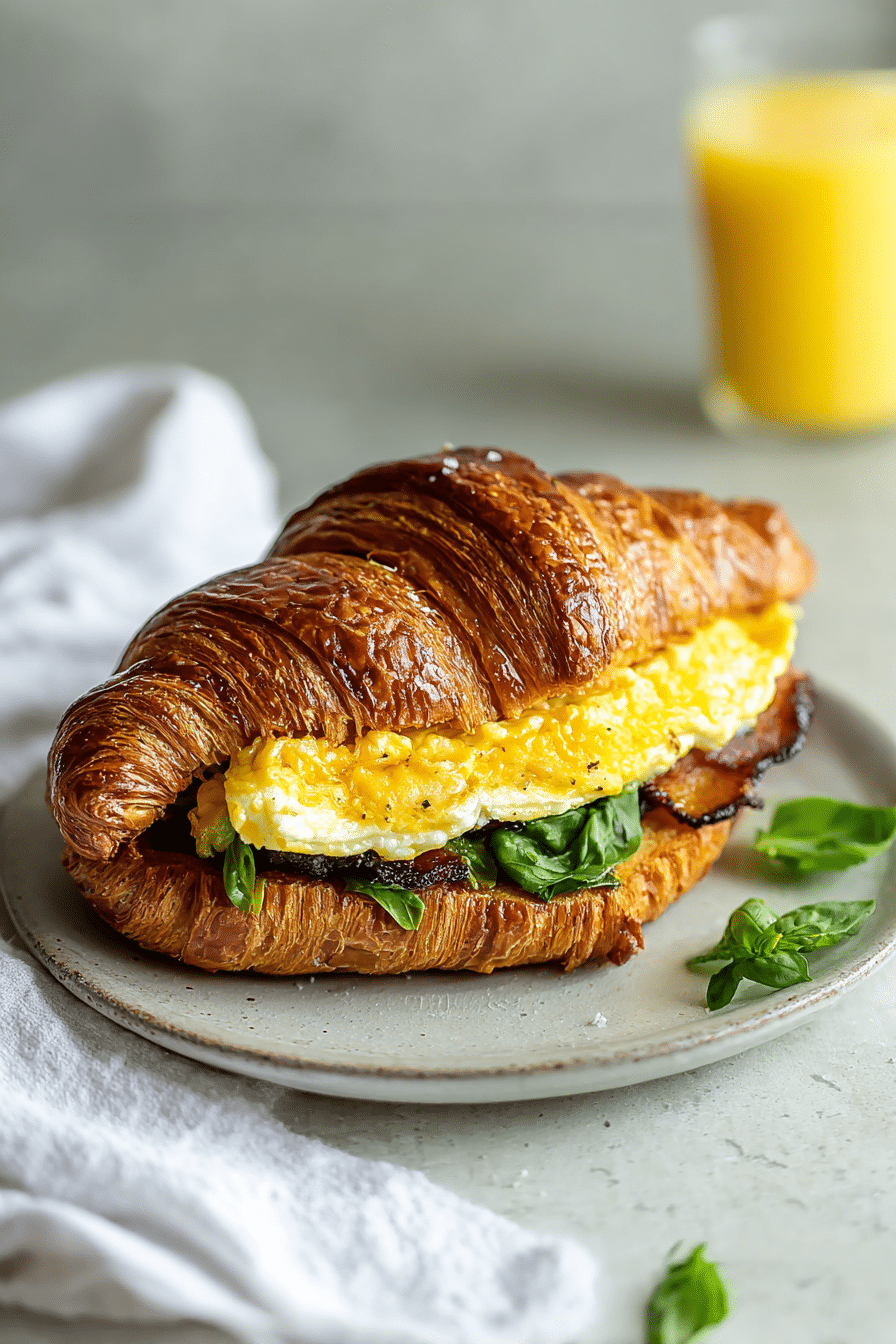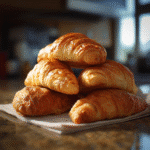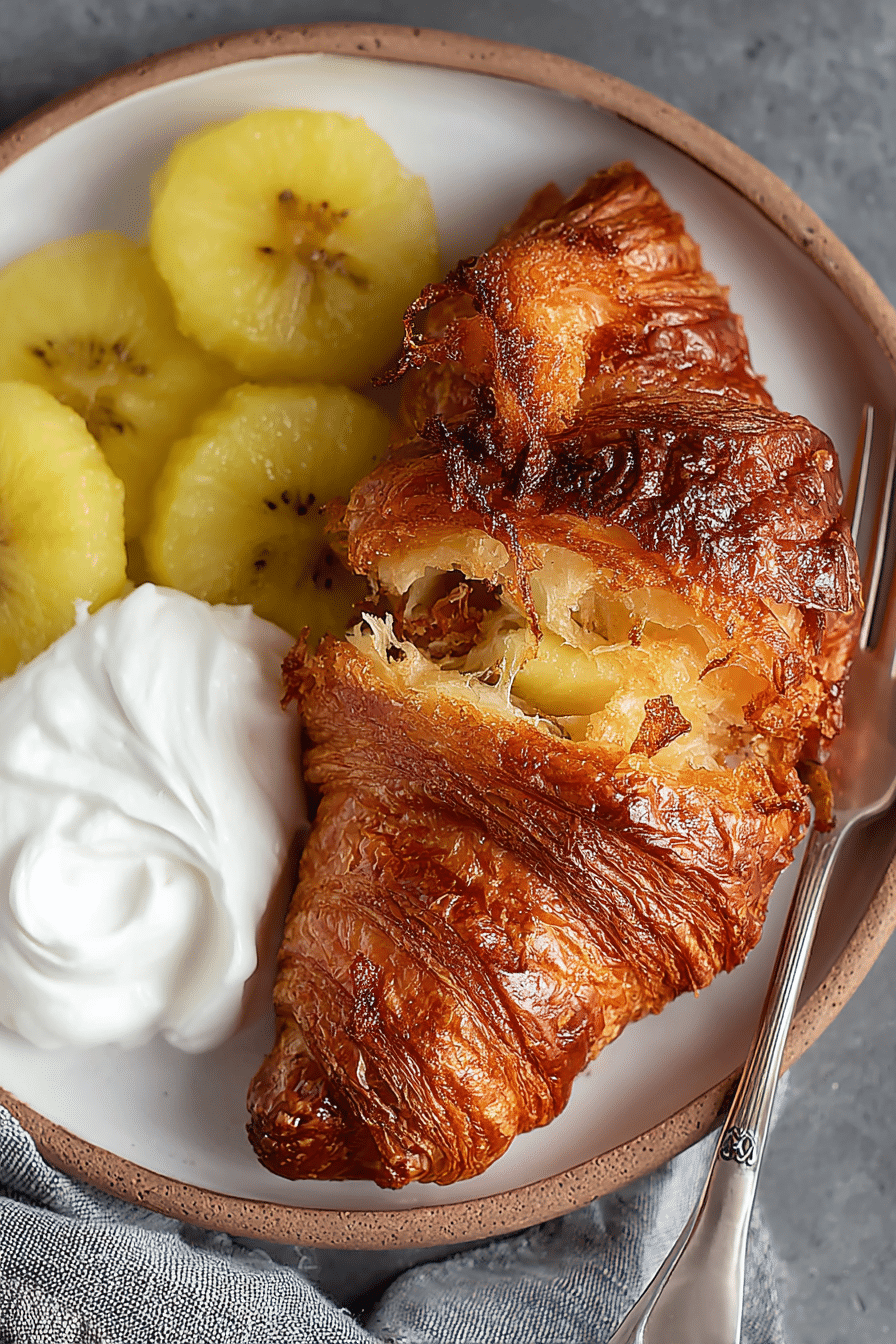If you’ve ever found yourself tossing a giant pack of Costco croissants into your cart “just because,” you’re not alone. I do it too. There’s just something about those golden, flaky layers that screams comfort food meets wholesale genius. Whether you’re making next-level breakfast sandwiches or sneaking one straight out of the container at midnight (guilty!), Costco croissants are one of those cult-favorite bakery staples you never regret buying.
In this guide, I’ll break down everything you need to know—from how many calories are in a Costco croissant to creative ways to use leftovers. Plus, we’ll look at baking frozen croissants from scratch, how to store them, and if they’re actually made in-house at Costco (spoiler: they are!). Let’s get buttery, shall we?

Jump to:
Table of Contents
Why Costco Croissants Are a Cult Favorite
The French-style layers you can’t resist
Costco’s croissants aren’t just big—they’re beautifully laminated. That’s a fancy term for the process of folding butter into dough multiple times to create dozens of airy, flaky layers. The result? A pastry that practically shatters when you bite into it. Light on the inside, crisp on the outside, and perfectly rich without being greasy.
Ingredients behind the magic: Is it real butter?
Yes—and no. Costco’s standard croissants are made with margarine or shortening rather than 100% butter, which helps explain why they’re a bit more affordable. But don’t worry, they still taste amazing. For the butter lovers out there, look for their Costco butter croissants or the frozen “all-butter” versions for that extra-rich taste.
Who makes Costco croissants? (Hint: it’s in-house!)
One of the best-kept secrets about Costco’s baked goods? Most are made fresh right inside the warehouse. According to multiple sources, Costco bakery teams proof, bake, and package the croissants daily—especially in high-traffic stores. That explains the bakery-fresh aroma you smell when you pass the bread section.
Shape and taste evolution: Why they changed in 2020
Remember when Costco’s croissants used to be straight and more airy? In 2020, they switched to a tighter, crescent shape—and shoppers noticed. The reason? Better consistency and easier packaging. Some fans miss the original shape, but most agree the new ones are just as tasty, if not better.


Costco Croissants Guide
- Prep Time: 10 minutes
- Cook Time: 20 minutes
- Total Time: 30 minutes
- Yield: Varies
- Category: Bakery Hack
- Method: Mixed
- Cuisine: American
Description
Everything you need to know about Costco’s iconic croissants—from calories and baking tips to creative leftover hacks.
Ingredients
- 1 pack of Costco croissants (12-count or mini)
- Butter or margarine (for baking/filling)
- Eggs (for French toast or egg wash)
- Cheese (cheddar, Swiss, or preferred)
- Cooked meats (bacon, sausage, ham, or turkey)
- Fresh herbs and vegetables (e.g. arugula, tomato)
- Jam, cream cheese, or almond paste (for sweet variations)
- Broth, onions, herbs (for stuffing)
- Optional toppings (chocolate chips, maple syrup, powdered sugar)
Instructions
- Use croissants for sandwiches by slicing and filling with deli meat, cheese, and vegetables.
- Make croissant French toast by dipping halves in egg-cinnamon batter and grilling until golden.
- Turn leftovers into stuffing by tearing and mixing with broth, herbs, and onions.
- Make sliders by filling with pulled pork or meatballs and warming in the oven.
- Bake sweet versions with almond paste, chocolate, or cream cheese inside.
- To freeze, wrap croissants individually and store in a zip-top freezer bag.
- To reheat, thaw at room temperature and warm in a 300°F oven for 6–8 minutes.
- For frozen, unbaked croissants: proof overnight, brush with egg wash, and bake at 375°F for 15–20 minutes.
- Use baked croissants for bread pudding or croissant toast.
Notes
Costco croissants can be used in endless ways—savory or sweet. Don’t forget to check for frozen options in the freezer aisle for fresh-baked quality anytime.
Nutrition
- Serving Size: 1 croissant
- Calories: 330
- Sugar: 4g
- Sodium: 370mg
- Fat: 17g
- Saturated Fat: 6g
- Unsaturated Fat: 11g
- Trans Fat: 0g
- Carbohydrates: 33g
- Fiber: 1g
- Protein: 6g
- Cholesterol: 35mg
Keywords: Costco croissants, breakfast sandwich, French toast, croissant hacks, Costco bakery
Costco Croissants Nutrition & Calories Breakdown
Calories in a Costco croissant (standard & mini)
Let’s be honest—we all tell ourselves we’ll just eat half. But whether you’re having one or three, here’s the lowdown: a standard Costco croissant contains around 300 to 330 calories. That includes about 17 grams of fat, 5–6 grams of protein, and around 30–33 grams of carbs. The mini croissants (usually found in the party trays) have about 110–130 calories each, depending on size.
Costco croissant nutrition facts: carbs, fat, protein
Here’s a quick macro snapshot for a full-size croissant from the bakery section:
- Calories: 330
- Total Fat: 17g (6g saturated)
- Carbohydrates: 33g
- Sugar: 4g
- Protein: 6g
- Sodium: 370mg
These values can vary slightly by batch, but it’s a good ballpark to use when planning meals—or tracking macros.
How healthy are Costco croissants?
Here’s the thing: croissants aren’t exactly superfoods, but as an occasional indulgence or meal base, they can fit into a balanced diet. They’re high in fat (mostly from butter or margarine), but also relatively low in sugar compared to donuts or muffins. If you’re watching carbs or sodium, just be mindful of your portion size—or try the mini version for more control.
Comparing Costco croissants to Starbucks and Panera
Costco’s croissants actually stack up pretty well against popular coffee shop versions. For example, a butter croissant from Starbucks clocks in at about 260 calories, while Panera’s buttery option is a hefty 320+. Costco’s are bigger, but more affordable per serving. And let’s be honest—they taste just as good (if not better) with a hot cup of coffee or filled with sandwich fixings.
Speaking of sandwiches, don’t miss the incredibly popular Costco croissant sandwich platter—perfect for parties or meal prep without the work.
All the Ways to Use Costco Croissants (Meal Hacks + Leftovers)
Breakfast ideas: croissant sandwiches, French toast, and more
Let’s start with the most obvious (and arguably most delicious) option—breakfast! Slice a Costco croissant in half and stuff it with scrambled eggs, cheddar, and sausage or bacon for a next-level breakfast sandwich. Or go sweet and try croissant French toast: slice them open, dip in an egg-cinnamon batter, and griddle until golden. Top with maple syrup and berries. You’re welcome.
Lunch hacks: turkey, ham & cheese, chicken salad
Croissants make amazing sandwich bread because they hold up well and stay flaky. I love using them for chicken salad or tuna salad sandwiches. Pro tip: add arugula and sliced tomato to balance the richness. You can also go classic deli style with turkey and Swiss or ham and cheddar. Warm them slightly to make the cheese melty and irresistible.
Dinner upgrades: croissant stuffing, sliders, and quiches
Got extra croissants? Turn them into savory magic. Tear them into chunks and make a buttery croissant stuffing with herbs, sautéed onions, and broth. Or slice and fill with pulled pork or meatballs for quick sliders. Feeling fancy? Use cubed croissants in a crustless quiche or strata. It’s an easy way to give new life to day-old pastries.
Sweet spins: chocolate almond, cream cheese-stuffed, bread pudding
Craving dessert? Turn your croissants into chocolate almond pastries by spreading almond paste and adding chocolate chips before baking for a few minutes. Or try cream cheese and jam inside, baked until gooey. Got a crowd? Make croissant bread pudding with eggs, cream, vanilla, and sugar. Bonus: it’s just as good cold the next day.
How to freeze & reheat Costco croissants the right way
Costco’s value pack is generous—so don’t let them go stale. Here’s how to store them like a pro:
- To freeze: Wrap each croissant individually in plastic wrap, then place in a zip-top freezer bag. They’ll stay good for up to 2 months.
- To reheat: Defrost at room temp for an hour, then pop in a 300°F oven for 6–8 minutes until warm and crispy again.
For even more options, check out the Costco frozen croissants—they’re raw and ready to bake fresh anytime you want that “just out of the oven” magic.

Costco Frozen Croissants: Bake-at-Home Brilliance
Where to find them: freezer aisle vs bakery section
If you haven’t yet explored the frozen section at Costco, you might be missing their best-kept secret: frozen, unbaked croissants. Unlike the pre-baked ones from the bakery, these are sold raw and ready to rise—literally. You’ll typically find them in a large freezer box labeled “All Butter Croissants” or “Au Pain Doré.” They come in packs of 20–30 and bake up like they came from a French café.
How to bake frozen unbaked croissants (step-by-step)
Baking frozen Costco croissants is super easy if you plan ahead. Here’s how to do it:
- Step 1: Line a baking sheet with parchment paper and arrange the frozen croissants a few inches apart (they’ll grow… a lot!).
- Step 2: Let them proof overnight (8–10 hours) at room temperature, covered loosely with plastic wrap or a towel.
- Step 3: Preheat your oven to 375°F (or 350°F for convection ovens).
- Step 4: Brush lightly with egg wash for a golden top (optional).
- Step 5: Bake for 15–20 minutes until puffed and deep golden brown.
Let them cool slightly before diving in (if you can wait). The smell alone is outrageous—in the best way.
Best tips for flaky, golden results
- Use a metal baking tray, not glass, for crispier bottoms.
- Don’t crowd the pan—they need space to puff.
- Use an oven thermometer—many ovens run hot or cold!
- If you want a shiny top, brush with a mix of egg + splash of milk before baking.
And here’s a fun twist: Slice baked croissants and use them to make Costco croissant bread—aka the ultimate grilled cheese or croissant toast. It’s rich, indulgent, and ridiculously satisfying.
How long do frozen Costco croissants last?
When stored properly in the freezer, these unbaked croissants can last up to 2 months without losing flavor or quality. Be sure to reseal the box or use a zip-top freezer bag to prevent freezer burn. Once baked, they’re best eaten within 24 hours—but you can reheat them for up to 3 days and still get good results.
Cost Breakdown – Are Costco Croissants Really a Bargain?
How much are croissants at Costco?
Costco’s croissants are famously affordable. As of this year, you can expect to pay about $6.99 for a 12-pack of large, buttery croissants. That’s less than $0.60 per croissant—wild when you consider that a single pastry at your local bakery could easily cost $3–$4 each. Even with the price increase (they were $5.99 just a couple years ago), they’re still one of the best bakery buys around.
Are the frozen ones cheaper per unit?
Yes—and no. A box of Costco frozen croissants typically costs around $18–$20, but you get 20–30 raw croissants depending on the brand (often Au Pain Doré or La Boulangère). That brings the price per croissant down to about $0.60 to $0.80 each. So you’re paying slightly more than the bakery version, but for bake-at-home convenience and pure butter flavor, many say it’s worth the bump.
Costco vs. the competition
Here’s how Costco croissants stack up against popular alternatives:
| Store | Price Per Croissant | Butter Content | Pack Size |
|---|---|---|---|
| Costco (Bakery) | $0.58 | Partial butter/margarine | 12-pack |
| Costco (Frozen) | $0.60–$0.80 | All butter | 20–30-pack |
| Whole Foods | $2.50+ | All butter | Singles |
| Trader Joe’s | $1.20–$1.50 | All butter | 2–4 pack |
| Starbucks | $3.25 | All butter | Singles |
Bottom line? Costco offers unbeatable value whether you’re feeding a family, hosting a brunch, or just want croissants on demand without breaking the bank.
Frequently Asked Questions About Costco Croissants
Does Costco make their own croissants?
Kind of! Costco’s bakery section does bake croissants in-house daily, but they don’t make the dough from scratch. Instead, they receive pre-formed dough (often from trusted suppliers) and bake them fresh. That’s why you’ll see them warm and golden in the bakery every morning.
How to bake frozen unbaked croissants?
Baking frozen croissants from Costco is easy but requires patience. You need to proof them overnight (8–10 hours) at room temp so they rise and get fluffy. Then, bake at 375°F for about 15–20 minutes until they’re beautifully golden. Don’t forget to brush them with an egg wash for that pro-level sheen!
How to prepare pre-made croissants?
If you’re working with the ready-to-eat bakery ones, you can simply enjoy them as-is. But to take it up a notch, try warming them in the oven at 300°F for 5–7 minutes. They’ll regain that crisp, flaky texture that makes them so irresistible. Add fillings like turkey, egg, or Nutella for an easy upgrade.
Can you buy frozen croissants from Costco bakery?
Yes, but not in the same area. The frozen croissants are sold in the freezer section, not the bakery. Look for boxes labeled “All Butter Croissants” or “Au Pain Doré.” These are unbaked and need to be proofed and baked at home—but they taste just like something from a Parisian café!
Why are Costco croissants so good?
Simple answer: butter + bulk = perfection. Costco croissants are big, fluffy, and lightly crisp with just the right amount of richness. While they don’t use 100% butter (they combine butter and margarine), their size and freshness win fans every time. Bonus? You get a whole dozen for less than the cost of 2 pastries at a coffee shop.
Does Costco bake their own pastries?
Yes! Costco’s bakery team bakes all pastries—including croissants, muffins, and cookies—on-site daily. While many of the items come from pre-portioned or frozen dough, they’re baked fresh each morning, ensuring that soft, warm texture we all crave. So technically, they’re “made fresh” in-house without being “made from scratch.”
Worth the Hype? 1000x Yes
So, are Costco croissants worth it? In my (very buttery) opinion—absolutely! Whether you’re grabbing a 12-pack of ready-to-eat pastries from the bakery or keeping frozen unbaked croissants stashed for a Sunday bake-fest, these flaky beauties offer serious value, taste, and versatility.
They work for breakfast, lunch, snacks, and dessert—and they freeze beautifully. Plus, you just can’t beat the price. Pro tip? Keep your eye out for seasonal or specialty versions, like Costco almond croissants—they’re next-level delicious and usually go fast!
If you’re anything like me, once you start using Costco croissants in everything from French toast to sandwich sliders, there’s no going back. So the next time you’re walking past the bakery or freezer section, grab a pack. Or two. Trust me—you’ll use every single one.